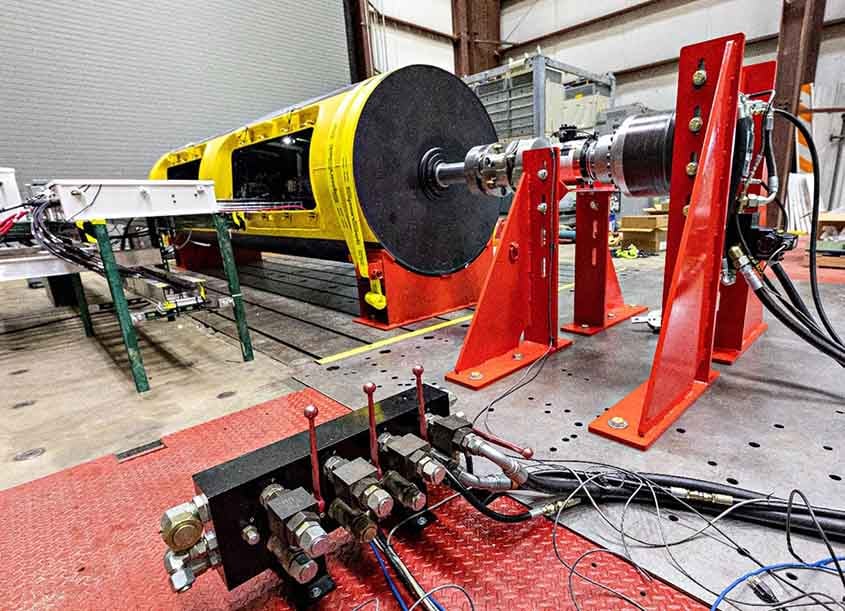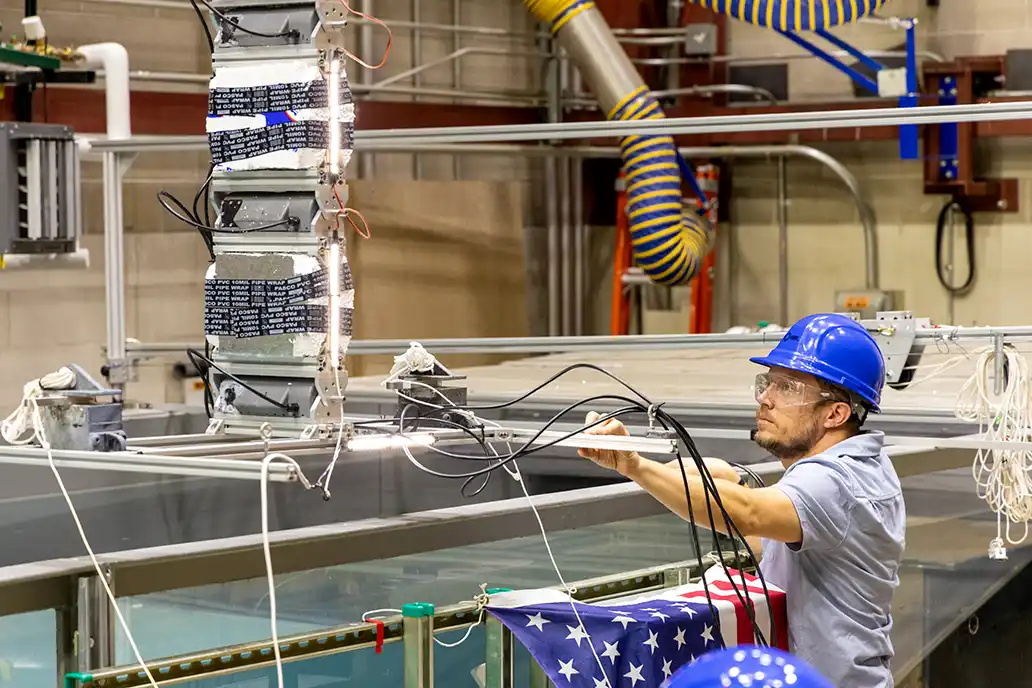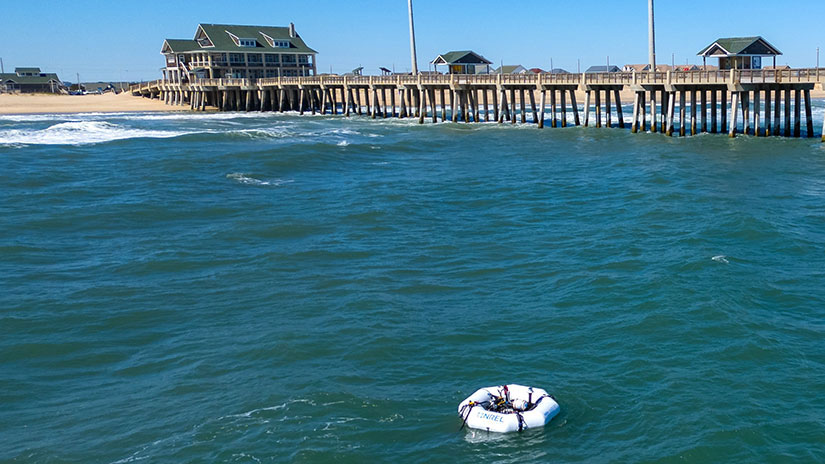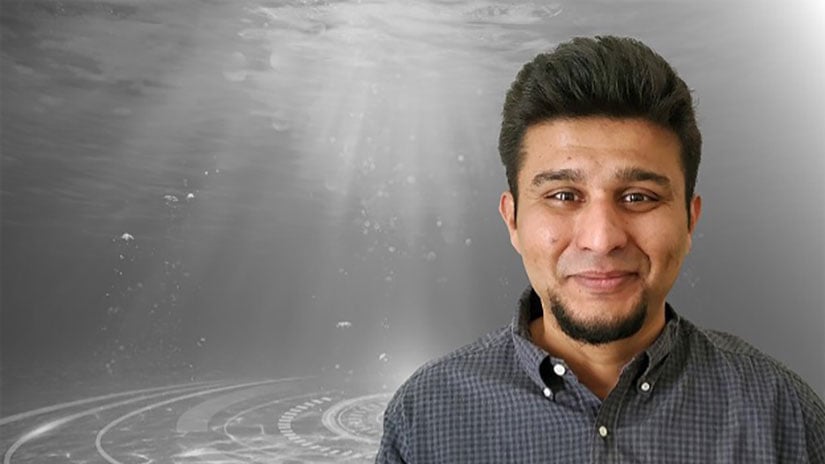NREL Water Power Newsletter, The Current, Summer 2025
In this issue, learn about NREL's water power achievements in the Accomplishments Report, explore a new video on HERO WEC, catch up on hydropower and marine energy news, and more.
This quarterly newsletter highlights the latest from NREL's Water Power Program.
Subscribe to Newsletter
To receive quarterly updates about NREL water power news, accomplishments, events, and more, subscribe to The Current newsletter.
SUBSCRIBEIn This Issue
NREL Featured in Annual Accomplishments Report
Highlight: NREL Projects Featured in Water Power Annual Accomplishments Report
We are celebrating NREL's water power research highlights in the Water Power Accomplishments Report: Fiscal Year 2024. In 2024, NREL's water power research embraced a range of disciplines and technologies to advance hydropower, marine energy, and more. This report dives into some of our biggest accomplishments from the past year.
What To Watch
The Journey of HERO WEC
The hydraulic and electric reverse osmosis wave energy converter, or HERO WEC, is a straightforward solution that turns salt water into drinking water, all while pushing the small-scale wave-powered desalination industry forward. See how an interdisciplinary team that spans the United States has created, deployed, and shared insights into NREL's first ocean-deployed marine energy desalination device.
Crosscutting News

A recent feature story highlights NREL's extensive water power testing capabilities, aiming to inspire collaboration and partnership among the lab's energy researchers and developers. NREL's capabilities include the large-amplitude motion platform and the Sea Wave Environmental Lab wave tank—ideal for wave energy converter testing—plus machines called dynamometers that can be used to research and validate device hardware and electronics, all of which can be used for marine energy, pumped storage hydropower, and hydropower. Altogether, NREL facilities offer developers the comprehensive, computer-to-ocean testing they need to get their technologies closer to the prototype stage.
Hydropower News
Video Shows How the Cybersecurity Value-at-Risk Framework Can Help Secure Hydropower Facilities
Researchers from NREL have released an updated version of the web-based Cybersecurity Value-at-Risk Framework (CVF). The framework provides an industry-accessible, self-guided, automated tool that will allow hydropower plant managers to identify best practices and make sound cybersecurity decisions for their systems. Watch the video to learn more about the CVF.
Take a Look at NREL's Hydropower Emulation Platform
Field validation for new and emerging hydropower technologies is risky, expensive, and time-consuming. However, with NREL's hydropower emulation platform, users can develop and validate next-generation controls for hydropower applications under various grid conditions before they are ever connected to the grid. Leveraging NREL's ARIES platform, the hydropower emulation platform emulates hydropower in a controlled, real-world environment, mimicking how hydropower plants pair up with energy storage and other energy technologies to provide more reliable energy to a grid. Check out this video to learn more about the platform.
Marine Energy News
Updated Risk Management Framework Supports Marine Energy Technology Development

The revised Marine Energy Risk Management Framework outlines key steps in the technology development process—such as lab validation of marine energy devices, as shown here—to reduce risks and increase the chances of success. Photo by Gregory Cooper, NREL
NREL's updated risk management framework supports the advancement of new marine energy technologies and increases their chances of success by helping developers identify, manage, and respond to risks throughout the development cycle. Covering projects of any technology readiness level or technology performance level and all risk types, the framework will be used for projects from the U.S. Department of Energy (DOE) Water Power Technologies Office that require system validation in open water.
NREL Report Shares Marine Energy Data Acquisition Best Practices and Cost Considerations
Device validation—which relies on high-quality data acquisition systems—is a vital step in advancing marine energy technologies through technology readiness levels. The NREL report, Data Acquisition and Control for Marine Energy Devices: Cost Considerations, outlines key considerations for developers when designing a data acquisition system and provides a foundation for estimating data acquisition project expenses using NREL's own Modular Ocean-source Data Acquisition System as a model. The report highlights the crucial role of front-end engineering design, emphasizing the importance of developing a comprehensive and detailed data acquisition plan before initiating device testing. By planning ahead, developers can ensure efficient use of both time and resources. Check out the Discovering the Ocean Through Data: NREL's Modular Ocean-source Data Acquisition System video on YouTube to learn more about the Modular Ocean Data Acquisition System.
Lessons Learned From Wave-Powered Desalination Device Deployments Help Guide Next Iteration

Over the course of five deployments, NREL's HERO WEC has proven to be a fully functioning wave energy converter that can desalinate seawater. Those deployments have also provided valuable lessons that will inform a new version of the HERO WEC. The NREL team has three primary objectives for the next HERO WEC iteration: robustness, reliability, and deployability. The team will begin by making revisions to the mooring setup and then move on to other design components, like downsizing the hydraulic pump and considering a more rigid frame. Learn more about the upgrades the team plans to make this year, and see how this project advances research for wave-powered desalination.
Aquatic Acrobatics: University Collaboration Visualizes the Future of Flexible Wave Energy
Recently, inside the Sea Wave Environmental Lab at NREL's Flatirons Campus, Isabel Hess prepared to perturb a flexible wave energy converter prototype from its equilibrium position. Hess is a Ph.D. student in mechanical engineering at the University of Florida who primarily studies underwater soft robotics through the university's Fluids and Adaptive Structures Lab. She is also a fellow of DOE's Marine Energy Graduate Student Research Program, which provides access to experts, resources, facilities, and funding support, including a monthly stipend and tuition reimbursement. See how Hess and her team are pioneering visual diagnostics to characterize flexible wave energy devices.
Newly Released OpenFAST Tutorials for Researchers and Developers
As part of the current marine turbine modeling project communications work, NREL released two tutorial videos on the NREL Learning YouTube channel related to installing and running OpenFAST. OpenFAST is a powerful, open-source tool designed to help marine turbine developers simulate energy generation, predict rotor loads, and analyze floating platform motions. The Installing OpenFAST Tutorial on YouTube makes it easy to get started by guiding you through the installation process on Mac and Windows. The Running OpenFAST Tutorial on YouTube explains how to navigate files, execute regression tests, and ensure that your OpenFAST setup is ready to power your simulations.
Beneath the Surface: Salman Husain

In the latest Beneath the Surface profile, researcher Salman Husaintalks about how his love for complex dynamics problems and interest in mechanical engineering led him to focus on the open-ended problem of wave energy. He began his tenure at NREL as an intern and was hired as a full-time researcher on NREL's marine energy team to create simulations and numerical models for wave energy converters. His models help other marine energy researchers predict how their devices will perform in real-world conditions, ultimately helping optimize wave energy converter design and efficiency.
NREL in the News
NREL research informs the potential of wave energy:
Could Wave Energy Become the New Nuclear? Forbes
DOE funding of projects on hydropower's ability to respond to changing demand on the electric grid:
DOE Invests Almost $15 Million for Hydro Grid-Balancing Projects, Hydro Review
U.S. DOE Invests Nearly U.S. $15 Million To Enhance Hydropower's Ability To Support Electricity Grids, Energy Global
PacWave set to begin open-water testing of wave energy technologies:
How To Turn Ocean Waves Into Renewable Energy, Yahoo! News
How To Turn Ocean Waves Into Renewable Energy, ABC News
Testing Expertise and Access to Marine Energy Research program approves funding for 15 marine energy projects:
U.S. Research Program Awards $1.9 Million to Marine Energy Projects, Offshore Energy
Missouri researcher awarded DOE grant to improve hydropower efficiency:
Science and Technology Researcher Awarded $750,000 DOE Grant Focused on Hydropower, Renewable Energy Magazine
Missouri Science and Technology Researcher Secures $750,000 DOE Grant To Improve Hydropower Efficiency, International Water Power and Dam Construction
University of Michigan receives DOE funding to work with NREL to improve wave energy devices:
$5 Million To Improve Testing, Durability, and Noise Levels of Wave Energy Devices, Offshore Wind, University of Michigan News
Cargo ship uses wave energy to produce green ammonia fuel while at sea:
Purpose-Built Ship Deploys Wave Energy To Produce Green Ammonia Fuel at Sea, Clean Technica
NREL's Stuart Cohen talked to Yale University about pumped storage hydropower:
Pumped Hydro Systems Could Help Solve the Challenge of Renewable Energy Storage, Yale Climate Connections
Publications
In-Situ Blade Strain Measurements and Fatigue Analysis of a Cross-Flow Turbine Operating in a Tidal Flow, Renewable Energy (2025)
Hygrothermal Aging and Recycling Effects on Mechanical and Thermal Properties of Recyclable Thermoplastic Glass Fiber Composites, Polymer Composites (2024)
HERO WEC V1: Design and Experimental Data Collection Efforts, NREL Technical Report (2024)
Want More?
Subscribe to The Current to get the next water power newsletter in your inbox.
Subscribe to The SPLASH to get the next STEM newsletter in your inbox.
For the latest from DOE's Water Power Technologies Office, sign up for its water power newsletters. Have a general question or can't find what you're looking for? Send us an email at [email protected].
Share
Last Updated Nov. 14, 2025
